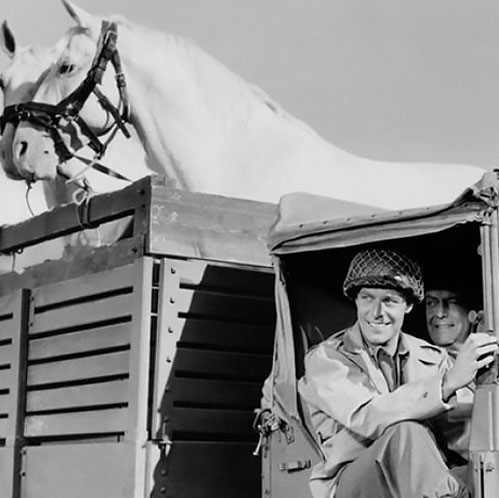
In 1963 an American studio released a movie named “Miracle of the White Stallions” on the rescue of the horses from the Hostouň farm; its name directly evoked the pearly manes of the Lipizzaner stallions from the famous Viennese school. Yet the mayors in the villages where Operation Cowboy took place only learned of it 2006—from enthusiasts mapping the suppressed history of the region’s liberation by the US Army.
In April when World War II swept back into Czechoslovakia for its final battles, one key task was to protect this farm for rare horses from the merciless consequences of war. Two German military veterinarians in Hostouň – Dr. Rudolf Lessing and Dr. Wolfgang Kroll – risked a daring act. They crossed the borders of the former Czechoslovak Republic, contacted the US Army leadership, and presented a request for the protection of the rare Lipizzaners.
As it happened, the cavalry command in the given area was already planning an action of its own. It centered around the liberation of British, French, and American soldiers from German captivity. And thus in the end the American commander of the 2nd Cavalry Group, Colonel Charles H. Reed—a cavalryman in heart and soul—ultimately decided to join the prisoners’ liberation and the horses’ salvation into one action.
He entrusted Captain Stewart with reaching Hostouň along with the German veterinarians and negotiating with the German command to arrange for soldiers to clear the areas around the stud farm, the yards, and the desired path for the horses’ travel. Likewise a sort of “gentlemen’s agreement” was laid forth regarding a full ceasefire in these areas. The Germans’ position was hopeless in these final days of war, and so their leadership acquiesced to this proposal. On April 28, 1945, Troop C of the 42nd squadron attacked Bělá nad Radbuzou, and its Troop A, bolstered with additional platoons, occupied both Hostouň and other stables in nearby villages without any problems.
One might say the task was then halfway done. A thirty-member American force led by Lieutenant Bill Quinlivan remained in the village. These soldiers were suddenly cowboys and horse-tenders – and indeed the subsequent operation was code-named “Cowboy.” Even though the war was still ongoing, a plan was prepared for transferring the horses past the border. When the Germans finally surrendered nine days later, on May 7, 1945, nothing more stood in the way of this plan. On May 15, the horses began to be transported through the deep Šumava forests into Schwarzenberg and from there into Sankt Martin, near Neustadt, and ultimately to Genova, Italy.
One portion of the Lipizzaners later returned to Hofburg, while another went to Lipica, Slovenia, while a smaller portion was transported to the USA. In 1946, photographs of these horses at an Army training center in Virginia appeared in Stars and Stripes, the daily newspaper of the US Army. That was a year after the war, and both the horses and those who had encountered them could now live in peace and freedom.